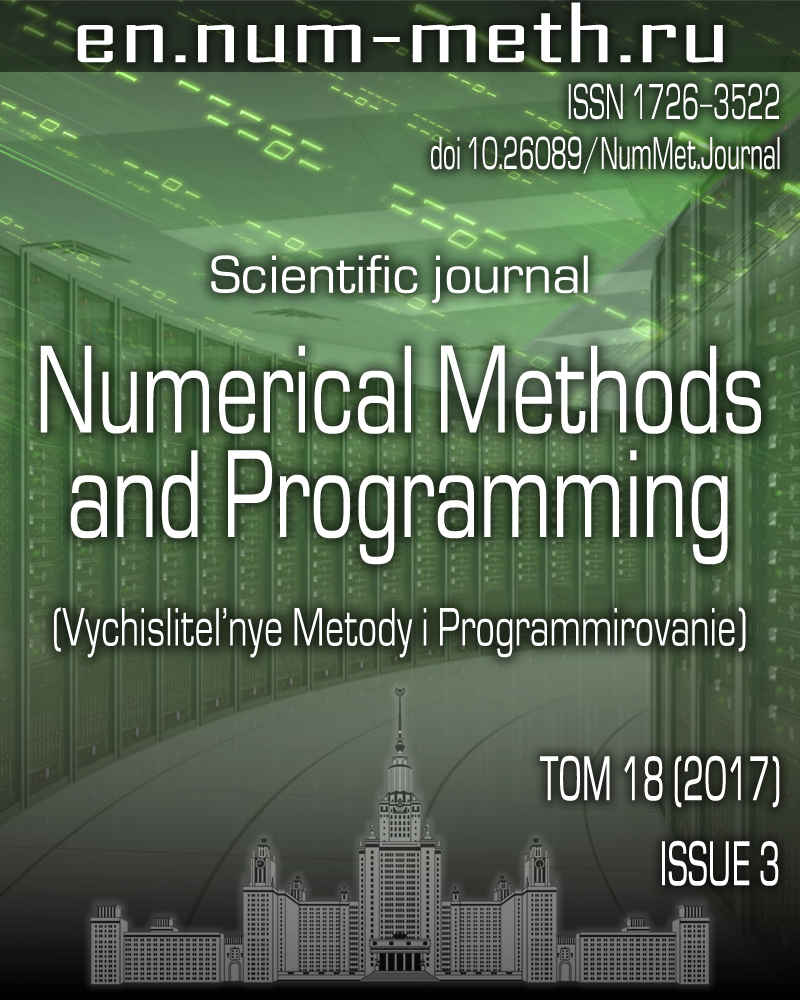DOI: https://doi.org/10.26089/NumMet.v18r323
Inverse problems of layer-by-layer ultrasonic tomography with the data measured on a cylindrical surface
Keywords:
Abstract
This paper is dedicated to developing efficient methods to solve inverse problems of wave tomography. The proposed new scheme of layer-by-layer tomography of 3D objects uses the experimental data measured on a cylindrical surface. This scheme provides the measurements of both the reflected and the transmitted waves and can easily be implemented in practice. The mathematical model used to solve the inverse problem takes into account the ultrasound diffraction and absorption effects. The authors developed efficient numerical methods to reconstruct the sound speed cross section using the tomographic data measured on the cylindrical surface. These methods are aimed primarily at early breast cancer diagnosis. The inverse problems of ultrasonic tomography are nonlinear and very computationally expensive. The efficiency of the developed methods is illustrated via numerical simulations. The numerical algorithm is implemented on GPU.
Published
Issue
Section
References
- V. A. Burov, D. I. Zotov, and O. D. Rumyantseva, “Reconstruction of the Sound Velocity and Absorption Spatial Distributions in Soft Biological Tissue Phantoms from Experimental Ultrasound Tomography Data,” Akust. Zh. 61 (2), 254-273 (2015) [Acoust. Phys. 61 (2), 231-248 (2015)].
- R. Jiří k, I. Peterlí k, N. Ruiter, et al., “Sound-Speed Image Reconstruction in Sparse-Aperture 3-D Ultrasound Transmission Tomography,” IEEE Trans. Ultrason. Ferroelectr. Freq. Control {IEEE} Transactions on Ultrasonics, Ferroelectrics, and Frequency Control 59 (2), 254-264 (2012).
- J. Wiskin, D. Borup, S. Johnson, et al., “Three-Dimensional Nonlinear Inverse Scattering: Quantitative Transmission Algorithms, Refraction Corrected Reflection, Scanner Design, and Clinical Results,” J. Acoust. Soc. Am. 133 (5), 3229-3229 (2013).
- J. Mamou and M. L. Oelze (Eds.), Quantitative Ultrasound in Soft Tissues (Springer, Dordrecht, 2013).
- S. Schmidt, N. Duric, C. Li, et al., “Modification of Kirchhoff Migration with Variable Sound Speed and Attenuation for Acoustic Imaging of Media and Application to Tomographic Imaging of the Breast,” Med. Phys. 38 (2), 998-1007 (2011).
- R. K. Saha and S. K. Sharma, “Validity of a Modified Born Approximation for a Pulsed Plane Wave in Acoustic Scattering Problems,” Phys. Med. Biol. 50 (12), 2823-2836 (2005).
- A. V. Goncharsky, S. Yu. Romanov, and S. A. Kharchenko, “The Inverse Problem of Acoustic Diagnosis for Three-Dimensional Media,” Vychisl. Metody Programm. 7, 113-121 (2006).
- A. V. Goncharskii and S. Yu. Romanov, “Two Approaches to the Solution of Coefficient Inverse Problems for Wave Equations,” Zh. Vychisl. Mat. Mat. Fiz. 52 (2), 263-269 (2012) [Comput. Math. Math. Phys. 52 (2), 245-251 (2012)].
- F. Natterer and F. Wubbeling, “A Propagation-Backpropagation Method for Ultrasound Tomography,” Inverse Probl. 11 (6), 1225-1232 (1995).
- L. Beilina, M. V. Klibanov, and M. Yu. Kokurin, “Adaptivity with Relaxation for Ill-Posed Problems and Global Convergence for a Coefficient Inverse Problem,” J. Math. Sci. 167 (3), 279-325 (2010).
- A. V. Goncharsky and S. Y. Romanov, “Supercomputer Technologies in Inverse Problems of Ultrasound Tomography,” Inverse Probl. 29 (7), (2013).
doi 10.1088/0266-5611/29/7/075004 - A. V. Goncharsky, S. Y. Romanov, and S. Y. Seryozhnikov, “A Computer Simulation Study of Soft Tissue Characterization Using Low-Frequency Ultrasonic Tomography,” Ultrasonics 67, 136-150 (2016).
- A. V. Goncharsky and S. Yu. Romanov, “Iterative Methods for Solving Inverse Problems of Ultrasonic Tomography,” Vychisl. Metody Programm. 16, 464-475 (2015).
- A. V. Goncharsky, S. Yu. Romanov, and S. Yu. Seryozhnikov, “Problems of Limited-Data Wave Tomography,” Vychisl. Metody Programm. 15, 274-285 (2014).
- A. V. Goncharsky and S. Yu. Romanov, “On a Problem of Ultrasonic Tomography,” Vychisl. Metody Programm. 12, 317-320 (2011).
- A. Goncharsky, S. Y. Romanov, and S. Y. Seryozhnikov, “Supercomputer Technologies in Tomographic Imaging Applications,” Supercomput. Frontiers Innov. 3 (1), 41-66 (2016).
- A. V. Goncharsky and S. Yu. Romanov, “Supercomputer Technologies in the Development of Methods for Solving Inverse Problems in Ultrasound Tomography,” Vychisl. Metody Programm. 13, 235-238 (2012).
- N. Duric, P. Littrup, C. Li, et al., “Breast Ultrasound Tomography: Bridging the Gap to Clinical Practice,” in Proc. SPIE 8320 Medical Imaging 2012: Ultrasonic Imaging, Tomography, and Therapy (2012).
doi 10.1117/12.910988 - A. V. Goncharsky and S. Y. Romanov, “Inverse Problems of Ultrasound Tomography in Models with Attenuation,” Phys. Med. Biol. 59 (8), 1979-2004 (2014).
- A. V. Goncharsky and S. Y. Romanov, “Iterative Methods for Solving Coefficient Inverse Problems of Wave Tomography in Models with Attenuation,” Inverse Probl. 33 (2), (2017).
doi 10.1088/1361-6420/33/2/025003 - A. V. Goncharsky, S. Yu. Romanov, and S. Y. Seryozhnikov, “Inverse Problems of 3D Ultrasonic Tomography with Complete and Incomplete Range Data’’ Wave Motion 51 (3), 389-404 (2014).
- A. V. Goncharsky, S. Yu. Romanov, and S. Yu. Seryozhnikov, “Low-Frequency Three-Dimensional Ultrasonic Tomography,” Dokl. Akad. Nauk 468 (3), 268-271 (2016) [Dokl. Phys. 61 (5), 211-214 (2016)].
- A. V. Goncharsky, S. Yu. Romanov, and S. Yu. Seryozhnikov, Supercomputing Technologies in the Design Problems of Tomographic Diagnostics (Politekh. Univ., St. Petersburg, 2016) [in Russian].
- A. N. Tikhonov, “Solution of Incorrectly Formulated Problems and the Regularization Method,” Dokl. Akad. Nauk SSSR 151 (3), 501-504 (1963) [Sov. Math. Dokl. 5 (4), 1035-1038 (1963)].
- A. Bakushinsky and A. Goncharsky, Ill-Posed Problems: Theory and Applications (Kluwer, Dordrecht, 1994).
- F. Natterer, “Sonic Imaging,” in Handbook of Mathematical Methods in Imaging (Springer, New York, 2015), pp. 1253-1278.
- L. Beilina and M. V. Klibanov, Approximate Global Convergence and Adaptivity for Coefficient Inverse Problems (Springer, New York, 2012).
- B. Engquist and A. Majda, “Absorbing Boundary Conditions for the Numerical Simulation of Waves,” Math Comp. 31, 629-651 (1977).
- Vl. V. Voevodin, S. A. Zhumatii, S. I. Sobolev, et al., “The Lomonosov Supercomputer in Practice,” Otkrytye Sistemy, No. 7, 36-39 (2012).
- A. E. Bazulin, E. G. Bazulin, A. Kh. Vopilkin, et al., “Application of 3D Coherent Processing in Ultrasonic Testing,” Defektoskopiya 50 (2), 46-65 (2014) [Russ. J. Nondestruct. Test. 50 (2), 92-108 (2014)].
License
Copyright (c) 2017 Вычислительные методы и программирование

This work is licensed under a Creative Commons Attribution 4.0 International License.

